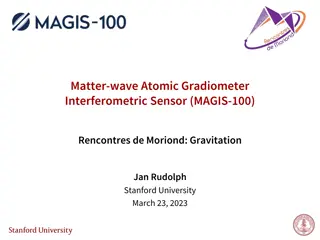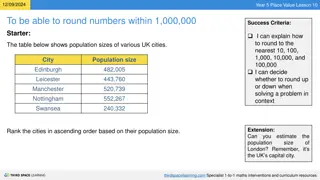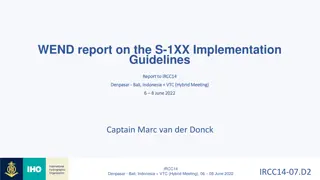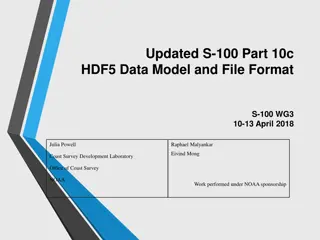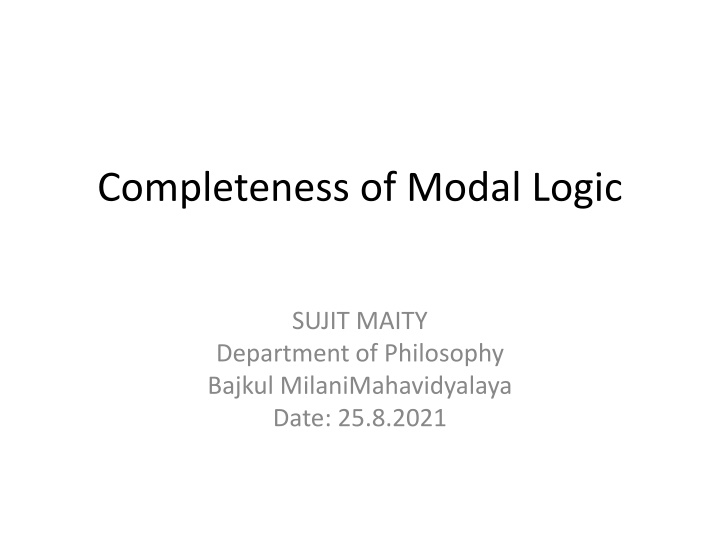
Completeness in Modal Logic
Completeness in modal logic ensures that every valid statement can be proven within the logical system. It encompasses syntactic and semantic completeness, demonstrating the robustness and utility of the logic in capturing modal relationships. A complete axiomatization guarantees the system's ability to represent all valid inferences. Explore the theoretical and practical implications of completeness in various fields.
Download Presentation

Please find below an Image/Link to download the presentation.
The content on the website is provided AS IS for your information and personal use only. It may not be sold, licensed, or shared on other websites without obtaining consent from the author. If you encounter any issues during the download, it is possible that the publisher has removed the file from their server.
You are allowed to download the files provided on this website for personal or commercial use, subject to the condition that they are used lawfully. All files are the property of their respective owners.
The content on the website is provided AS IS for your information and personal use only. It may not be sold, licensed, or shared on other websites without obtaining consent from the author.
E N D
Presentation Transcript
Completeness of Modal Logic SUJIT MAITY Department of Philosophy Bajkul MilaniMahavidyalaya Date: 25.8.2021
Introduction Completeness in modal logic refers to the property of a logical system that ensures that every valid statement or formula that can be expressed within that system can also be proven or derived using the rules and axioms of that system. In other words, a modal logical system is complete if it captures all the valid inferences that can be made within its framework.
Definition of Completeness Completeness is an important quality because it provides a guarantee that the logical system is capable of fully representing and capturing the semantic relationships between statements involving modal operators like "necessity" and "possibility."
Main aspects of completeness in modal logic Syntactic Completeness: A modal logic is syntactically complete if every valid formula can be derived or proven using the formal rules of the logic. This involves showing that the logical system has sufficient axioms and inference rules to systematically deduce all valid conclusions. Semantic Completeness: A modal logic is semantically complete if it captures all the valid relationships between statements in its associated Kripke semantics (which define the meaning of modal operators in terms of possible worlds and accessibility relations). Semantic completeness ensures that the logical system faithfully represents the intended interpretations of necessity and possibility.
Theoretical and Practical implications of Completeness Theoretical Significance: A complete modal logic is a desirable property because it shows that the logic is robust and capable of fully capturing the range of possible modal relationships. It demonstrates the logical richness and expressiveness of the system. Practical Utility: Completeness guarantees that the logical system can be relied upon for capturing and reasoning about modal concepts, making it a useful tool for applications in various fields like philosophy, computer science, and artificial intelligence.
Concept of a complete axiomatization for a logical system A complete axiomatization for a logical system refers to a set of axioms and inference rules that, when combined, are capable of deriving or proving every valid statement within that logical system. In other words, a logical system is complete if it can capture and express all the valid relationships and inferences that can be made using its language and rules of deduction. Completeness is a fundamental property of a logical system that ensures it is capable of fully representing the entire range of valid conclusions that can be drawn within that system. It provides a strong assurance that the logical framework is comprehensive and reliable for reasoning about the concepts it encompasses.
Types of completeness in logic: Syntactic syntactically complete if every valid formula can be derived or proven using the axioms and inference rules of the system. This involves demonstrating that the logical rules are powerful enough to systematically deduce all possible valid conclusions. Semantic Completeness: semantically complete if it captures all the valid relationships between statements in its intended semantics (interpretations). Semantic completeness ensures that the logical system faithfully represents the intended interpretations of its symbols and operations. Completeness: A logical system is A logical system is
Several reasons of Completeness : Assurance of Soundness: Completeness ensures that the logical system is capable of accurately capturing valid inferences, which reinforces the soundness of the system. Soundness means that if a statement is provable using the system's rules, it is indeed valid. Expressive Power: A demonstrates the full expressive power of the logical system, allowing it to handle complex and nuanced reasoning tasks. Practical Applicability: A complete system is more reliable and useful in practical applications, as it can be relied upon to capture all relevant relationships and inferences. complete axiomatization
Challenges in achieving completeness for Modal logic Complexity of Modal Operators: Modal operators introduce new layers of complexity to the logical system. They allow statements to refer to different possible worlds, which can lead to intricate semantic structures and require specialized rules for reasoning. Semantic Diversity: Modal logic is used to reason about a wide range of modalities, including necessity, possibility, knowledge, belief, time, and more. Different interpretations of modal operators may lead to different logical systems, each with its own set of axioms and rules. Possible Worlds Semantics: Modal logic often relies on possible worlds semantics, where the truth of statements is evaluated across multiple possible worlds and relations between them. Formally defining these semantics and proving completeness within such a framework can be challenging.
Cont. Adequate Axiomatization: Finding a set of axioms and inference rules that capture the diverse range of modal relationships and inferences can be complex. Ensuring that these axioms are both sound and complete requires careful consideration. Interaction of Modalities: Modalities in modal logic can interact in intricate ways. For example, combining necessity and possibility can lead to complex combinations like "It is necessarily possible." Capturing these interactions comprehensively is not always straightforward. Multiple Quantifiers and Operators: Modal logic can involve combinations of modal operators, quantifiers (such as "forall" and "exists"), and other logical connectives. Ensuring completeness in such contexts requires a deeper understanding of how these elements interact.
Proof Techniques: Proving completeness often involves sophisticated proof techniques, such as constructing canonical models or using modal tableau methods. These techniques may be more complex than those used in simpler logics. Limitations of Model Theory: Traditional model-theoretic approaches used to prove completeness may have limitations when dealing with certain modal logics, making it challenging to establish completeness in those cases. Variety of Modal Logics: There are numerous modal logics, each tailored to different applications or modalities. Proving completeness for specific modal logics may require addressing specific challenges unique to that logic.
Kripke Semantics and Completeness Introduce Kripke semantics for modal logic Possible Worlds: In Kripke semantics, a logical system is interpreted over a collection of possible worlds, each representing a distinct state of affairs or a way the world could be. These possible worlds capture different scenarios, situations, or configurations of reality. Accessibility Relations: For each world, an accessibility relation is defined that specifies which other worlds are considered accessible from that world. This relation reflects the idea that some possible worlds are "accessible" from others, representing the concept of relative possibility or necessity. Interpretation of Modal Operators: Necessity ( ): A statement is true at a world w if is true in all worlds accessible from w. Possibility ( ): A statement is true at a world w if is true in at least one world accessible from w. Validity and Models: A Kripke model is a structure consisting of a set of possible worlds, an accessibility relation for each world, and an assignment of truth values to atomic propositions in each world. A formula is considered valid in a Kripke model if it is true in all possible worlds of the model. Semantic Consequence: A formula is semantically entailed by a set of formulas (written as ) if, in every world where all the formulas in are true, is also true. This captures the notion of logical implication within the Kripke semantics.
Discuss how Kripke semantics contribute to completeness proofs Defining Validity: Kripke semantics offers a clear and formal definition of validity within a modal logic. A formula is valid in Kripke semantics if it holds true in all possible worlds of a given Kripke model. This concept of validity serves as the foundation for completeness proofs. Establishing Soundness: Kripke semantics helps establish the soundness of a logical system. If a formula can be derived or proven within the system, it should hold true in all possible worlds according to Kripke semantics. This soundness property ensures that the logical rules are reliable and do not lead to invalid conclusions. Canonical Models: Kripke semantics often involves constructing canonical models, which are special Kripke models designed to capture the logical relationships and modalities of a given modal logic. Canonical models serve as a reference point for proving completeness by demonstrating that certain formulas are valid within the model. Completeness Criteria: Kripke semantics provides criteria for proving completeness. A modal logic is considered complete if it can capture and express all the valid relationships and inferences that Kripke semantics defines. Proving that a logical system can derive or prove all valid formulas within the Kripke semantics establishes its completeness. Witnesses and Counterexamples: Kripke semantics allows for the identification of witnesses or counterexamples that illustrate the truth or falsehood of formulas in specific worlds. This helps in constructing proofs of completeness by showing that the logical system is capable of capturing all such cases. Model-Theoretic Arguments: Completeness proofs often involve model-theoretic arguments that rely on Kripke semantics to reason about the behavior of modal operators and their implications across possible worlds. These arguments demonstrate that every valid formula is either already an axiom or can be derived using the rules of inference. Challenging Modalities: Kripke semantics helps completeness proofs address complex and challenging modalities by offering a way to systematically evaluate the truth conditions and relationships of formulas involving modal operators.
Example of Kripke models and their role in completeness Kripke Model: Imagine a Kripke model with three possible worlds: w1, w2, and w3. The accessibility relations are as follows: w1 is accessible from w2 and w3. w2 is accessible from w1. w3 is accessible from w1. Assign truth values to atomic propositions as follows: At w1: A is true, B is false, C is true. At w2: A is true, B is true, C is false. At w3: A is false, B is false, C is true.
Completeness Proof: To prove completeness, we need to demonstrate that every valid formula can be derived within the logical system using the given Kripke semantics. Let's consider the formula A B. We want to show that this formula is valid, which means it should be true in all possible worlds of the Kripke model. Using Kripke semantics, we check the truth values of A and B in each world: A is true at w1 (A is true), true at w2 (A is true), and false at w3 (A is false). B is true at w1 (B is false), true at w2 (B is true), and false at w3 (B is false). Therefore, A B is true at w1 and w2, making it valid in this Kripke model.
Applications of Consistency and Completeness Applications of Consistency and Completeness Highlight practical applications of consistency and completeness results in modal logic Mention areas like artificial intelligence, verification of software and hardware, and philosophical reasoning

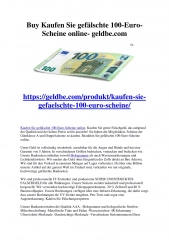


![[PDF⚡READ❤ONLINE] Tutankhamun's Trumpet: Ancient Egypt in 100 Objects from the](/thumb/20549/pdf-read-online-tutankhamun-s-trumpet-ancient-egypt-in-100-objects-from-the.jpg)





